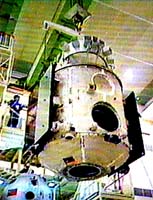| . |  |
. |
|
by Robert J. Saiget  Beijing (AFP) November 21, 1999 - China successfully completed the first test launch in its ambitious manned space flight program Sunday as an unmanned space vehicle returned to earth after orbiting the planet 14 times.
Beijing (AFP) November 21, 1999 - China successfully completed the first test launch in its ambitious manned space flight program Sunday as an unmanned space vehicle returned to earth after orbiting the planet 14 times.Named "Shenzhou" by President Jiang Zemin, the space craft landed at 3:41 a.m. local time (1941 GMT Saturday) after a 21-hour flight, the state news agency Xinhua reported. The vehicle was launched with the new generation "Long March 2-F" rocket at 6:30 a.m. Saturday from the new Jiuquan Satellite Launch Center in northwest China's Gansu Province, China's third rocket launch center. An undated image from Chinese television footage shows a part of the experimental spacecraft at the Jiuquan Satellite Launch Center in northwest China's Gansu Province. The space craft, named 'Shenzhou' by President Jiang Zemin, is part of China's manned space flight program and has completed a short mission in space touching down in Inner Mongolia 21 November 1999. CCTV/AFP Photo Ten minutes after takeoff, the spaceship detached itself from the launching vehicle and entered a preset orbit, Xinhua said. The space craft orbited the earth at an altitude of 300 kilometers (180 miles). It was the first of "several" unmanned test flights to be carried out before China attempts to place the first Chinese national in space, the semi-official China News Service reported. State television reported the launch after the space capsule safely returned to earth. The three-stage space craft, which was composed of a propulsion unit and an orbital and re-entry vehicle, was monitored by the Beijing-based command center and four survey ships located around the globe. In brief video footage, the re-entry capsule appeared to resemble the Apollo series of capsules launched by the National Aeronautics and Space Administration (NASA) of the United States in manned flights to the moon in the late 1960s. Three parachutes aided the landing and four retro rockets fired just before touch down in a computer simulated landing also shown by China Central Television. Footage of the landing site showed the blackened capsule on its side with its parachute lines stretching across a field in eastern Inner Mongolia as technicians climbed inside and inspected the capsule. China's manned space program is the third in the world, following the former Soviet Union and the United States. The short flight was "another milestone in China's astronautical history," Xinhua said. "The successful launching and retrieval of the spaceship marks the country's new major breakthrough in manned space flight technology." In a series of reports on the flight, Xinhua made it clear the program was aimed at boosting national pride and championing the leadership of President Jiang and the Communist Party, which is celebrating its 50th anniversary of one-party rule this year. "It is significant for China to develop manned spaceflight technology as it will strengthen the country's comprehensive national strength, promote the development of science and technology, enhance national prestige and boost the nation's sense of pride and cohesiveness," Xinhua said. "Based on feasibility studies both technologically and economically, the Communist Party of China (CPC) Central Committee with Jiang Zemin at the core decided to carry out China's own manned spaceflight project in 1992. "Practice has demonstrated that the decision is 'absolutely correct'." The name of the space craft, "Shenzhou," means "Divine Ship" and has the same pronunciation as "divine land," a poetic name for China. The spacecraft was developed and manufactured mainly by the China Research Institute of Carrier Rocket Technology under the China Aerospace Science and Technology Corporation, the Chinese Research Institute of Space Technology and the Shanghai Research Institute of Astronautical Technology. The Beijing-backed daily Wen Wei Po in a report late last month said a 10-tonne craft would be launched from a newly set up satellite launching pad in Jiuquan in "the near future," citing experts in Beijing. Chinese space industry officials said this summer that China would be ready to launch its first manned space flight early next century. China has launched nearly 300 satellites since the early 1970s, some 25 for commercial use, while 16 out of 17 retrievable Chinese satellites have successfully returned to earth intact. China has launched nearly 300 satellites into space since the early 1970s, some 25 for commercial use, while 16 out of 17 retrievable Chinese satellites have successfully returned to earth intact.
Copyright 1999 AFP. All rights reserved. The material on this page is provided by AFP and may not be published, broadcast, rewritten or redistributed.
A POWERFUL DRAGON
Asian MilSpace Issues At SpaceDaily
|
| |||||||||
| The content herein, unless otherwise known to be public domain, are Copyright 1995-2016 - Space Media Network. All websites are published in Australia and are solely subject to Australian law and governed by Fair Use principals for news reporting and research purposes. AFP, UPI and IANS news wire stories are copyright Agence France-Presse, United Press International and Indo-Asia News Service. ESA news reports are copyright European Space Agency. All NASA sourced material is public domain. Additional copyrights may apply in whole or part to other bona fide parties. Advertising does not imply endorsement, agreement or approval of any opinions, statements or information provided by Space Media Network on any Web page published or hosted by Space Media Network. Privacy Statement All images and articles appearing on Space Media Network have been edited or digitally altered in some way. Any requests to remove copyright material will be acted upon in a timely and appropriate manner. Any attempt to extort money from Space Media Network will be ignored and reported to Australian Law Enforcement Agencies as a potential case of financial fraud involving the use of a telephonic carriage device or postal service. |